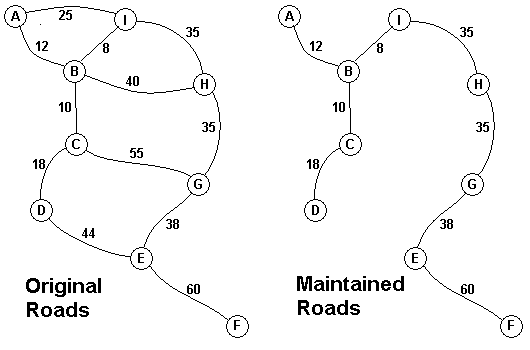
The Head Elder of the tropical island of Lagrishan has a problem. A burst of foreign aid money was spent on extra roads between villages some years ago. But the jungle overtakes roads relentlessly, so the large road network is too expensive to maintain. The Council of Elders must choose to stop maintaining some roads. The map above on the left shows all the roads in use now and the cost in aacms per month to maintain them. Of course there needs to be some way to get between all the villages on maintained roads, even if the route is not as short as before. The Chief Elder would like to tell the Council of Elders what would be the smallest amount they could spend in aacms per month to maintain roads that would connect all the villages. The villages are labeled A through I in the maps above. The map on the right shows the roads that could be maintained most cheaply, for 216 aacms per month. Your task is to write a program that will solve such problems.
Input
The input consists of one to 100 data sets, followed by a final line containing only 0. Each data set starts with a line containing only a number n, which is the number of villages, 1 < n < 27, and the villages are labeled with
the first n letters of the alphabet, capitalized. Each data set is completed with n-1 lines that start with village labels in alphabetical order. There is no line for the last village. Each line for a village starts with the village label followed by a number,
k, of roads from this village to villages with labels later in the alphabet. If k is greater than 0, the line continues with data for each of the k roads. The data for each road is the village label for the other end of the road followed by the monthly maintenance
cost in aacms for the road. Maintenance costs will be positive integers less than 100. All data fields in the row are separated by single blanks. The road network will always allow travel between all the villages. The network will never have more than 75 roads.
No village will have more than 15 roads going to other villages (before or after in the alphabet). In the sample input below, the first data set goes with the map above.
Output
The output is one integer per line for each data set: the minimum cost in aacms per month to maintain a road system that connect all the villages. Caution: A brute force solution that examines every possible set of roads will not
finish within the one minute time limit.
Sample Input
9 A 2 B 12 I 25 B 3 C 10 H 40 I 8 C 2 D 18 G 55 D 1 E 44 E 2 F 60 G 38 F 0 G 1 H 35 H 1 I 35 3 A 2 B 10 C 40 B 1 C 20 0
Sample Output
216
30
最小生成树
大意就是:第一行一个数字n代表城镇个数,接下来n-1行是n个城市间的距离关系,着n-1行每一行一个字母K和一个数字m,代表与K城镇相邻的有m个城镇,接下来m个字母与数字交替代表
与某个城市修路花费多少,求n个城市连成一棵树的最小花费
(英语不好是硬伤啊)
#include<cstdio>
#include<algorithm>
using namespace std;
int pre[92];
struct node{
int x, y, z;
} ans[100];
bool cmp(node a, node b){
return a.x < b.x;
}
int find(int x){
return x == pre[x] ? x : (pre[x] = find(pre[x]));
}
bool merge(int a, int b){
int fx = find(a), fy = find(b);
if(fx != fy){
pre[fy] = fx;
return true;
}
return false;
}
int main(){
int m, x, y, num, sum;
char ch, n;
while(scanf("%d", &m) == 1 && m){
sum = num = 0;
for(int i = 65; i < 91; i++){
pre[i] = i;
}
while(--m){
scanf(" %c%d", &ch, &y);
for(int i = 0; i < y; i++){
scanf(" %c%d", &n, &ans[num].x);
ans[num].z = (int)ch;
ans[num++].y = (int)n;//这里用强转算的,用char类型不会做。。。
}
sort(ans, ans + num, cmp);
for(int i = 0; i < num; i++){//克鲁斯卡尔,按权值从小到大排
if(merge(ans[i].y, ans[i].z)){
sum += ans[i].x;
}
}
printf("%d\n", sum);
}
return 0;
}





 本文介绍了一个热带岛屿Lagrishan的长老们面临的问题:如何在有限的预算内维护连接各个村庄的道路网络。通过使用最小生成树算法,文章提供了一种解决方案来确定哪些道路应该被维护以确保所有村庄仍能保持连接,同时成本最低。
本文介绍了一个热带岛屿Lagrishan的长老们面临的问题:如何在有限的预算内维护连接各个村庄的道路网络。通过使用最小生成树算法,文章提供了一种解决方案来确定哪些道路应该被维护以确保所有村庄仍能保持连接,同时成本最低。
















 543
543

 被折叠的 条评论
为什么被折叠?
被折叠的 条评论
为什么被折叠?








